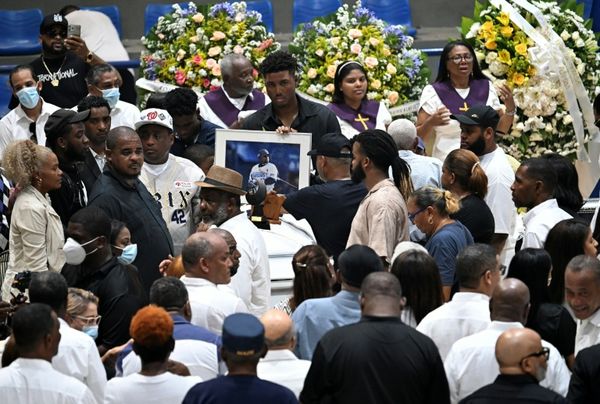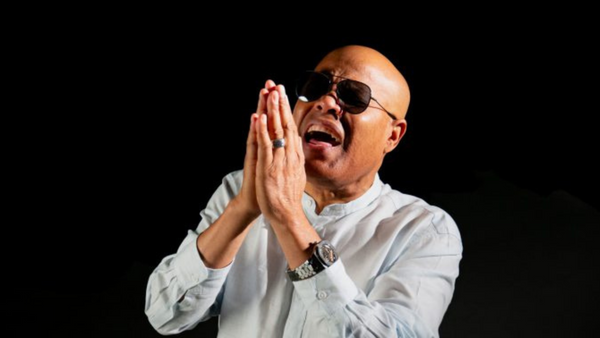
Upon entering the drab building housing Iraq’s culture ministry, visitors unexpectedly stumble upon some of the country’s greatest treasures. In a newly refurbished hall that used to be the cafeteria, 76 precious paintings and sculptures from Iraq’s foremost artists are on display for the first time since the National Museum of Modern Art was pillaged in the aftermath of the 2003 Iraq invasion.
“Art is the memory and conscience of the people,” said Fakhir Mohammed, head of the ministry’s “plastic arts directorate” that deals with contemporary paintings and sculptures. During a tour of the recently opened but sparsely visited exhibition hall, Mohammed said the return of artwork “to these walls is just part of our ambition”. He added: “Now there’s a real will to restore Iraqi culture to the previous level.”
Roughly 11,000 works of art were at the museum when the US invaded Iraq, a country that was once considered to be among the Arab world’s greatest cultural centres. In the ensuing chaos, looters ransacked museums and other institutions as American troops stood by. “What happened in 2003 was a painful blow to Iraq’s heritage and the plastic arts movement,” said Mohammed. “We suffer from it until today.”
Some pieces were hidden away by museum staff. Others were later found in local antique markets, including a sculpture by the renowned artist Jawad Salim. The wooden statue depicting a woman, entitled Motherhood, was worth $300,000 but was bought back from an unsuspecting dealer for $200. Still, the bulk of the pieces remain unaccounted for, with many likely to have been smuggled out of the country by international criminal networks to disappear into private collections.
The museum’s inventory today is a quarter of its original size. Fewer than 600 works have been officially returned, mostly by well-meaning private collectors. But Iraq has few legal channels to enforce restitution. The landmark 1970s Unesco convention on the illicit trafficking of cultural property is toothless unless destination countries agree to sign binding bilateral treaties that commit them to returning cultural objects.

“If the two parties do not agree, the convention remains valid, but it cannot be enforced,” said Junaid Sorosh-Wali, chief of culture at Unesco’s Iraq office. “Conventions provide a legal framework, but the goodwill should come from the parties.”
The process is further hampered by the lack of a comprehensive database of stolen works, and of funding for re-acquisition and upkeep. Across the hallway from the exhibition hall, more than 2,300 other paintings are crammed into storage. One-third are in dire need of restoration as a result of improper storage, but the ministry’s workshop has no equipment to carry out basic repairs.
Still, the returned artworks are a source of national pride and a priceless depository of collective memory for a nation that has suffered immeasurable loss. Spanning more than a century, they tell stories of occupations, uprisings and wars, taking visitors on a historical journey from Ottoman and British rule, to the monarchy, to the Baath era, until the first Gulf war.
Among the oldest paintings are the idyllic landscapes of Abdulqader al-Rassam, who travelled across the country in the service of the Ottoman empire, which ruled Iraq from the 16th century until it passed into British hands after the first world war. Rassam became part of a group of artists who spearheaded an awakening of Iraqi national identity at a time when the country yearned for self-determination.
Many of these “pioneer” artists were trained in Europe or the Ottoman empire and returned to Iraq to launch a new art movement, using modern techniques to popularise symbols of Iraqi folklore. Exemplary of this style is a mid-20th century colourful painting by Hafidh al-Droubi, a painter and art educator who studied in Rome and London and is most famous for using cubism to depict Baghdad life.
Alongside these peaceful scenes from Iraq’s heyday as a rising Arab nation are more unsettling paintings that recount – and at times foretell – its darkest days.
A 1958 painting by Tareq Madhloum commemorates the 1948 Wathba uprising, when throngs of students flooded Baghdad’s streets to reject British control and rising inequality. Titled The Eternal Bridge Battle, the painting fluidly overlays powerful scenes of the revolt, many of which evoke comparisons with the 2019 October Revolution. At the centre of the painting, security forces open fire at crowds attempting to cross Martyr’s Bridge, named after those killed in 1948. Both movements faced brutal repression, leaving hundreds dead.

Other works appear to portend violent events well ahead of their time. A 1976 painting by Faiq Hassan immediately rouses memories of the US bombing of a civilian air raid shelter during the first Gulf war. The large oil painting shows women and children, eyes and mouths open wide in terror, fleeing what appears to be an explosion. Remarkably, it was painted 14 years prior to the 1991 Amiriyah shelter bombing that killed more than 400 civilians.
To the right of the entrance hangs another ominous piece by Layla al-Attar, Iraq’s most famous female artist, who once served as the museum’s director. Peering through the dark trunks of a palm grove, the observer’s focus is drawn towards the centre, where a fire is raging over a distant residential area. Upon closer examination, the outline of the blaze resembles the map of Iraq, an allusion to the far-reaching impact of war. From the safety of the palm grove, a woman – possibly the artist – watches the inferno as though it is a premonition of her own death: al-Attar was killed by a US missile strike in 1993.
The successive conflicts that have plagued Iraq since the 1980s precipitated a decline in the culture scene long before 2003. While the mid-century pioneers had thrived during a period of upswing, by the 1990s their successors fled the stifling climate of wars, sanctions and Saddam Hussein’s dictatorship, leaving the art movement rudderless and the public deprived of its legacy.
Although the wars have since subsided, the country’s recovery is hamstrung by internal strife, corruption and mismanagement, all of which have eroded public attention towards art. Veteran artists reminisce about the days when exhibition halls were heaving with visitors and the government invested in the arts, often purchasing artworks to encourage burgeoning painters.
“The government is removed from the arts. We are frustrated because of that. They only care about themselves, not about the artists,” said Saad al-Tai, a 78-year-old artist whose painting is exhibited at the ministry. Dozens of Tai’s other works were lost in the 2003 looting. The artist maintains little hope that his paintings – or the golden age of the pioneers – will ever return.
“Iraqi society is still headed towards an unstable direction,” Tai said. “The conditions have forced people to retreat inwards. The artistic spirit is gone.”







